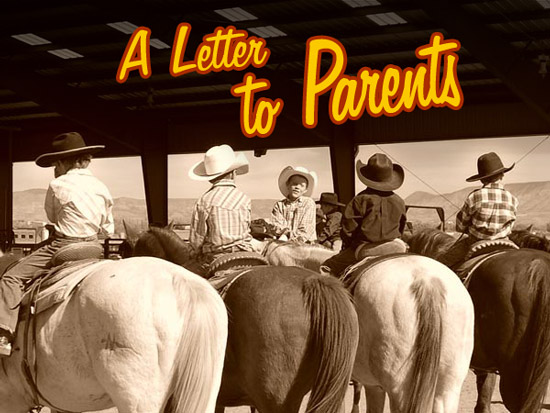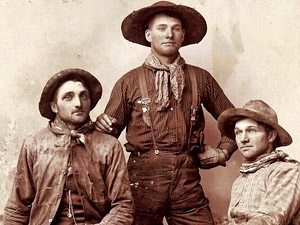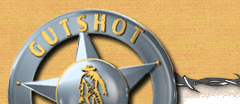|

What you will (and won't)
find in our products
Hawgleg Publishing is committed to creating family friendly products that appeal to gamers who appreciate classic action and adventure. As such, we are committed to producing products that -- if they were movies -- would be rated PG or PG-13.
That means you can be assured that our products do not contain nudity, profanity, excessive violence, racial intolerance, or other "gritty" topics that seem to be the rage these days. Specifically, this means that the strongest curse word you'll find is either "dang" or "damn." In our artwork, although you will see some pretty ladies every now and then, you will not see excessive cleavage or overt sexuality. We like our Gutshot ladies to be alluring but coy. The artwork will also not show excessive bloodshed or gore (our commitment is particularly strong for our upcoming game, Gutshot: Night of the Living Deadwood that features zombies and other monsters). To be honest, we three partners have discussed this issue at length and tend to agree that the classic Western and horror movies from the 1930s – 1970s showed the right levels of violence and blood that are appropriate for the types of games that we want to publish. After all, our games are set in the American Wild West and people get shot and people sometimes die. Western gaming is about action and adventure, not sitting down with a mediator to work out your differences.
This being said, however, Hawgleg Publishing does not produce lily-livered wussy games that sugar coat the past or dabble in revisionist history. We think that's wrong and, furthermore, the three of us actually think such efforts are part of an agenda that is designed to undermine the historical foundation of what made this country great in the first place: pride in who we are and what we've accomplished as a Christian nation coupled with a steadfast belief that self-reliance and hard work will inevitably lead to success.
Those political beliefs can be found by reading between the lines in our books, but you'll seldom find them spelled out in a preachy editorial or in overt messages. We leave those politics to our personal blogs and our personal lives. Gutshot and our other products are games and they are intended to be fun, not to serve as didactic tools for furthering our personal beliefs
History vs. Gaming
The American West is a real place, and all three of us were either born there, lived there, or at least visited it. We're familiar with what it looks like and how it smells, and we try to convey that information in our games as accurately as possible whenever we can. So, when we describe Tombstone, Arizona in 1888, we do our best to base those descriptions on real maps and first-hand accounts of that famous locale. The same is true for our descriptions of real people, weapons and technology. After all, none of us ever want your kid to fail a history test by quoting something from one of our books.
But keep in mind, Gutshot is a game and we like to make things up. A lot of the towns in our games are fictional and so are the people who live there. We try to make it clear which is which, but generally speaking, unless we specifically state that a person or place is real, you should count on it being a product of our imaginations.
 Gaming is a social activity Gaming is a social activity
We ain't gonna try to hornswaggle you (that is, try to fool you): We think historical miniatures gaming is better and healthier than video gaming. We have several reasons for this:
-
Miniatures gaming is face to face. You must physically interact with the other people at the gaming table. This improves social skills in regards to listening, taking direction, waiting your turn, teamwork, and generally playing well with others.
-
Miniatures gaming can improve analytical thinking because the players must devise strategies and execute them (and think on their feet when something goes wrong… and in a combat game, something is always going wrong).
-
Gutshot is set in the American Wild West: this was a real place with real locations and real people. Playing our games can improve your kids' skills with history and geography.
-
Speaking of interdisciplinary learning, we know many teachers who use games like this as cross-learning projects to include history, reading, geography, social studies (studying different cultures, American Indians, etc.), and even art (most miniatures are sold unpainted and kids enjoy painting them).
-
Gutshot involves a lot of measuring and adding modifiers to dice; as such, it reinforces math skills.
-
Miniatures don't need a game controller, so a game size is not limited by the number of controllers you have or the number of players supported by your software. Miniatures games can be as much fun with two players as they are with eight or more.
 The Gender “Bias” The Gender “Bias”
The fact is, historical miniature gaming mostly appeals to boys. Any parent who has watched their sons play knows that, for the most part, they are more violent and – honestly – hyper active than little girls. That’s not to say that this is exclusively a male activity, but based on our own observations, about 95% of all mini gamers are male.
For this reason, we use the male pronoun when we write. We're not trying to "disrespect" anyone, but we're not going to tap dance around thin-skinned feelings or waste a single breath (or keystroke) explaining why we think the proposed pronoun "s/he" is an abomination that would make buffalo barf. We'll make up for it by putting in some strong female characters in our games.
Also, gaming is a good father-son activity, particularly when there are other people playing in the group. This lets the boy blend in with the group and – if the game is being run well – he’ll be treated as “one of the guys” and allowed to make his own decisions and live (or “die”) with the consequences.
By the way, we’ve also had a fair number of moms join us at the table, and they enjoy playing with the boys, too. And we've seen many moms steal the game and winning the day.
How old is “Old Enough?”
This is one of the only areas where the three partners in Hawgleg Publishing disagree on specifics, but they have a general consensus on the appropriate age for playing Gutshot.
When Mike Mitchell runs games at conventions, there are never any age restrictions. As such, for the past 8 years at OwlCon, he’s always had at least one player under the age of 12 (and often 2-4 players out of 10). “I’ve never had any discipline problems, and only a few problems with kids under the age of 9. At that age they usually have problems waiting their turns or they get distracted by other things going on in the room. The boys from 10-13 sometimes need help figuring out the math involved with stacking modifiers, but they are fully capable of running one miniature and coming up with their own strategies and ideas. Sometimes the most inventive things I’ve seen have come from the younger kids.” He added that he's had players as young as 5-years old, and that's probably too young to pay attention for more than 30 minutes. The 7 and 8 year olds, though, were able to focus and – with a few rules tweaks (see below) – had a good time.
Paul Mauer prefers to run a more adult game, requiring his gamers to be over the age of 15. “They have a better grasp of the mechanics of the game at that age. The age requirement also helps speed up the game."
Michael Murphy prefers to run games for all ages, but based upon the scenario and requirements, he's learned over the years (numerous gunfights), that younger aged players are more interested in the "shoot 'em up" scenarios more than they are "achieve the goals to win" scenario., and thus tailors the age requirements for the games he runs.
"I've learned that at a certain age, the appeal of the game many times, especially if it's father and son in the game, is that the son seems to take a delight in using his Colt Peacemaker on Dear Old Dad…. and anyone else for that matter. That's why I think The Last Man Standing scenario is always so popular. It's King of The Hill with six shooters. No special objectives and everyone knows what they need to do. It puts new gamers and veteran gamers on an equal footing."
As kids get older, their playing style can develop also. From simple shoot 'em up games to learning how to work as a team/gang/posse, etc. It's the interaction and communication that you see being developed. When they are faced with a situation and they have to look at each other and come up with a plan. A good multi-game campaign like we've done in the past with several groups will encourage that, plus it's interesting to see player/character development as the game progresses.
When we developed Gutshot, we knew what we were looking for. We had been raised on Saturday morning westerns on TV; John Wayne Movies, and the B/W serials, and the endless miles of western serials from the 1930s featuring colorful characters, rip-roaring adventure, and plenty of excitement for a young kid.
To this day, none of us have yet to be approached by a concerned parent wanting to discuss that their child was playing something "dangerous" or that the game was encouraging him to embrace and commit acts of violence. You can look at it and say "It's a game, and it's basically playing cowboys." To be honest, we're more concerned about the subject matter in many video games nowadays, rather than Gutshot. A quick perusal of many of these games shows them to have very "mature" themes, and matter, if not a "R" restricted rating because of the amounts of violence, and other themes.
The Old West was a period of American History that helped shape our nation, and it's a period that is simply and purely, American. Gutshot does it's best to portray those times in a fun manner and allows players to experience a little of the "trail dust" without ending up on "Boot Hill."
| So in short, you might expect the following results with younger gamers, and here are some tips for running games with the young'uns. |
| 5-9 |
They might enjoy a short game, but probably don’t have the attention span required for a large, multi-player game. We suggest one adult acting as a Game Marshal (referee) and helping the kids with measuring, math and making gentle suggestions for tactics. It’s important to let them make their own decisions, though, as that helps them learn about strategy and cause/effect. If there are two or three young kids in the group, opt for a small town with clear objectives or a simple shoot-em-up game like "Last Man Standing". Also, keep the headcount down with no more than 5 players. The fewer the players, the faster there turn will come around again which will help to keep them engaged.
RULES CHANGES/ADULT RESPONSIBILITIES: Give each person just one name slip in the hat. This will make the game go much faster and decrease the level of chaos in the game (when dealing with young kids, you want to keep it fast and orderly). Avoid horses, Aiming, and more complex things. And remember that you are the one who knows the rules, so it is up to you to keep track of everyone's Specialties and remind them to mark off ammo each and every time they make a shot.
|
| 10-13 |
These players tend to be very active and a little “blood-thirsty,” so let them run wild. They will need a little help with measuring at first, but will quickly pick it up. They might need some help with the math, so check/ review it with them on each roll to make sure they (and you) aren’t forgetting any important modifiers. Again, a smaller town with clear objectives and no more than 8 players will make for a smoother game that is more fun for everyone.
RULES CHANGES/ADULT RESPONSIBILITIES: If your headcount is more than five people, seriously consider cutting the Action slips down to 1 or 2 per character. This is really important because you need to reduce the downtime between Actions, as this keeps things moving so the young 'uns don't have time to get bored while other people are doing their stuff. Above all else, keep the game moving. Avoid horses, Aiming, and more complex things. You will need to keep up with their Specialty modifiers and remind them about ammo.
|
| 14-15 |
These players generally get the gist of the main rules and can handle the measuring and math, but review things every now and then to make sure they are on track (periodically run the math with the kids prior to them rolling the dice to help them figure out if their shots hit). At this age, it’s possible to let them run more than one miniature, but having multiple figures tends to make them more foolhardy and take extreme risks. There’s nothing wrong with that, but a kid who gets killed off in the first 20 minutes of the game won’t have anything else to do while everyone else is playing, so often limiting them to one mini per game is a sound approach. At this age, we would remove any restrictions on game size or number of players.
RULES CHANGES/ADULT RESPONSIBILITIES: Even new players can handle Gutshot and most other games without a problem. Use the normal 3 Action Slips activation system and don't be afraid of horses or other complex material. You might want to occassionally remind them to check their sheet for Specialties and ammo, but you shouldn't have to watch them every second.
|
| 16-up |
Most of the time, these young men are ready to run with the big dawgs. They should easily handle the basic rules and are probably move on to the more advanced stuff. |
To sum it all up
Thanks fer trusting us with yer kids. We will continue to work toward maintaining that trust by producing quality products that represent our philosophical and political ideals. This means you can count on us to keep things relatively clean – at least PG-13 clean – and never publish a picture or photo that will make yer granny blush when she sees it.
Also, if you have any questions about using Gutshot (or miniature gaming in general) as a learning tool for a public school or home school, please contact us. We'll be happy to discuss it with you and help you create lesson plans or learning activities that will help make gaming an enriching social activity that will be a positive influence in your family's life.
Mike Mitchell, Mike Murphy, Paul Mauer
Hawgleg Publishing
02-15-2012
Updated 03-13-2017

|



![]()